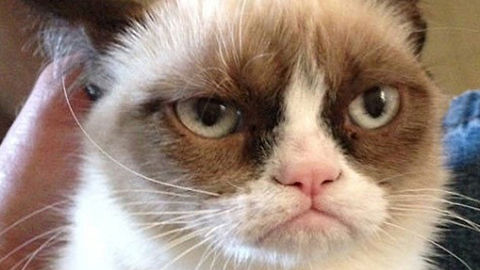World Cat News – Do you have grumpy kitty? Does your cat give you an attitude? Do you ever catch your cat staring at you, as if to say, “I could kill you right now … very easily”? There’s a reason for that: evolution. And cat grumpiness just might get worse in the future, thanks to the way we breed and adopt cats. But there are cures for a grumpy cat, according to the author of a new book about our feline friends.
British anthrozoologist John Bradshaw’s latest book, “Cat Sense,” delves into the depths of the kitty psyche. The way he sees it, the inscrutability of cats — and, ironically, their viral appeal — spring from the fact that cats aren’t all that far removed from natural-born, prehistoric killers.
“Their ability to be social … is only a few thousand years old,” Bradshaw told NBC News. “The cat’s domestication is incomplete, in terms of its need to continue hunting and also in terms of its ability to socialize. One of the consequences of that is it has a rather unexpressive face.”
That face serves as a blank canvas on which we project our own ideas of what a cat is thinking — whether it’s cute kittens striking seductive poses, Grumpy Cat scowling her way to Hollywood, or Henri, le Chat Noir, expressing existential world-weariness. Regardless of what you see on the outside, there’s a different agenda working inside that feline brain, balanced between domesticated cuteness and the killer instinct.
Our Favorite Grumpy Cat Video
In contrast, cats are biologically incapable of going strictly vegetarian, and they can’t taste sweets. A cat’s reliance on meat rather than starch is thought to be the reason why they were domesticated in the first place.
The cat-human relationship was apparently first forged in the Fertile Crescent, to protect granaries from mice and rats. Wildcats were probably caught and tethered to keep watch on the grain. Ancient Egyptians eventually bred cats as household pets and even revered them as gods. The rest is, well, hiss-tory.
A Cat’s Sights, Scents and Sounds
The fact that cats are only half-domesticated explains why they can seem standoffish. But it’s not just us: They’re hard- wired to be solitary hunters — bonding with their kin, but not so much with other cats. “There are misconceptions, like … if one cat is good, two cats are better,” Bradshaw said. On the contrary: Care has to be taken when introducing a new arrival to an established pet cat.
wired to be solitary hunters — bonding with their kin, but not so much with other cats. “There are misconceptions, like … if one cat is good, two cats are better,” Bradshaw said. On the contrary: Care has to be taken when introducing a new arrival to an established pet cat.
“It’s essential to introduce the two cats together very gradually, using scent first of all, and not the sight of it — because it’s the sight of the cat that might trigger the other cat to run away in fright. Mix their scents together to begin with, then allow the cats to see one other,” Bradshaw said. “Do the whole thing over the course of a week or more.”
Scents (yes, including a tomcat’s spray of urine) are how cats signal their presence to each other. If one cat rubs up against another, that signals acceptance — and perhaps an effort to share its scent. So take it as a compliment if your cat rubs up against you.
Some people might think a cat’s purr is a compliment as well, but Bradshaw said that’s not necessarily so. “Just purring, just this rattling of the vocal cords, is a basic piece of communication. It’s a request,” Bradshaw said. “The emotional content comes with the context.”
For example, kittens purr to signal their mother to lie still so they can nurse. Pet cats may purr to let their owners know they should keep stroking their fur. But they may use a different purr to signal hunger, or to signal stress. “If you interpret purring simply as a request for the other party to come close and attend to what the cat wants, it makes more sense,” Bradshaw said.
The Future of Felines
Although a cat naturally wants to prowl and hunt, Bradshaw said playing with an indoor cat — using toys as simple as a feather or a piece of string — will usually satisfy those urges sufficiently. “If you let the cat get that little bit of instinctive behavior … provided the cat is content and has an area it knows it’s not going to be threatened within, I think that’s all they’re looking for,” he said.
However, Bradshaw worries that current trends in cat breeding could lead to grumpier cats: Statistics from the Humane Society of the United States indicate that 88 percent of pet cats are spayed or neutered, compared with just 39 percent of free-roaming cats. As a result, free-roaming cats — which include feral cats and strays — produce about 80 percent of the kittens born each year.
House cats tend to be selected for their docility and friendliness to humans, but they’re quickly taken out of the gene pool. Meanwhile, feral and stray cats rely on their killer instincts and wariness of humans to survive and breed. Evolutionary pressures could tip the balance toward the less socialized, wilder side of the feline species. “The longer that continues, the more likely it is that the cat’s average temperament will become less amenable. We’re pushing domestication back,” Bradshaw said.
One of the strategies to counter that trend is to trap feral cats, neuter them and then return them to the streets. Bradshaw said genetics may provide another avenue for degrumpifying cats.
“Geneticists have found that there are a very small number of genes that define the domestic aspects of a cat,” he said. “When those are identified, and when we know what effect they have, then I think we would be in a better position to say, well, it would be possible to breed a cat that doesn’t really want to hunt … and a cat that finds it a little bit easier to get along with other cats. If we can identify those, then maybe we’ll generate a cat that is more suitable for urban living than the current model is.”
From Alan Boyle, Science Editor NBC News, Edited by Dan Stevens

